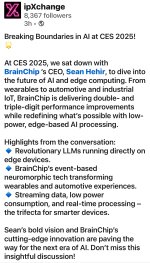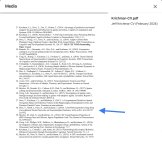About six months ago, I posted a video which showed that researchers at UC Irvine’s Cognitive Anteater Robotics Laboratory (CARL), led by Jeff Krichmar, had been experimenting with AKD1000 mounted on an E-Puck2 robot.
The April 2024 paper I linked to at the time (“An Integrated Toolbox for Creating Neuromorphic Edge Applications”), co-authored by Lars Niedermeier (Niedermeier Consulting, Zurich) and Jeff Krichmar (UC Irvine), did not yet contain a reference to Akida, but has recently been updated to a newer version (Accepted Manuscript online 22 January 2025). It now has heaps of references to AKD1000 and describes how it was used for visual object detection and classification.
Nikil Dutt, one of Jeff Krichmar’s colleagues at UC Irvine and also member of the CARL team, contributed to this Accepted Manuscript version as an additional co-author.
What caught my eye was that the researchers, who had used an AKD1000 PCIe Board (with an engineering sample chip) as part of their hardware stack, had already gotten their hands on an Akida M.2 form factor as well, even though BrainChip’s latest offering wasn’t officially revealed until January 8th at CES 2025:
“For productive deployments, the Raspberry Pi 5 19 Compute Module and Akida.M2 form factor were used.” (page 9)
Maybe thanks to Kristofor Carlson?
Here are some pages from the Accepted Manuscript version:
View attachment 76552
View attachment 76553
View attachment 76554
View attachment 76558
View attachment 76556
View attachment 76557
We already knew from the April 2024 version of that paper that…
And finally, here’s a close-up of the photo on page 9:
View attachment 76555
Just an afterthought…
Academic research utilising Akida shouldn’t generally be underestimated or dismissed as mere playtime in an ivory tower.
Some of these researchers have excellent connections to big players in the industry and/or to government agencies and sometimes even prior work experience in relevant sectors themselves - hence their recommendations would likely be given quite a bit of weight.
Take Jeff Krichmar

for example, whose 27 page (!) CV can be found on his LinkedIn profile.
Krichmar’s first job after graduating with a Bachelor in Computer Science (and before going to grad school to pursue his Master’s) was that of a software engineer at Raytheon Corporation (now RTX), working on the PATRIOT surface-to-air missile system - a position, which also saw him become a consultant to the Japanese Self-Defense Forces from 1988-1989, while deployed to Mitsubishi Heavy Industries in Nagoya (which to this day is manufacturing PATRIOT missiles for domestic use under license from RTX and Lockheed Martin).
Over the years, he has received quite a bit of funding from the defence-related sector, mostly from the US government, but also from Northrop Grumman.
In 2015 he gave an invited talk at Northrop Grumman…
… and he was co-author of a paper published in November 2016, whose first author, his then graduate student Tiffany Hwu, was a Basic Research Systems Engineer Intern with Northrop Grumman at the time. (“This work was supported by the National Science Foundation Award number 1302125 and Northrop Grumman Aerospace Systems.”)
The neuromorphic hardware used for the self-driving robot was unsurprisingly IBM’s TrueNorth, as this was then the only neuromorphic chip around - Loihi wasn’t announced until September 2017.
One of the paper’s other co-authors was a former postdoctoral student of Krichmar’s, Nicolas Oros, who had started working for BrainChip in December 2014 - on his LinkedIn profile it says he was in fact our company’s first employee! He is also listed as co-inventor of the
Low power neuromorphic voice activation system and method patent alongside Peter van der Made and Mouna Elkhatib.
Nicolas Oros left BrainChip in February 2021 and is presently a Senior Product Manager at Aicadium, “leading the development of a computer vision SaaS product for visual inspection”. I don’t think we’ve ever looked into them?

By the time of said paper’s publication, Jeff Krichmar had become a member of BrainChip’s Scientific Advisory Board - see this link of an April 2016 BRN presentation, courtesy of
@uiux:
As mentioned before, Kristofor Carlson is another of Jeff Krichmar’s former postdoctoral students (from 2011-2015), who co-authored a number of research papers with Jeff Krichmar and Nikil Dutt (both UC Irvine) over the years - the last one published in 2019.
In September, Kris Carlson gave a presentation on TENNs at UC Irvine, as an invited speaker at
SAB 2024:
From Animals to Animats - 17th International Conference on the Simulation of Adaptive Behavior.
Kris Carlson’s September 2024 conference talk on TENNs and the CARL lab’s recent video and paper featuring an E-Puck2 robot, which had an Akida PCIe Board mounted on top, as well as the additional info contained in that 22 January 2025 paper that CARL researchers had already experimented with the brand new AKD1000 M.2 form factor is ample evidence that there is continued interest in what BrainChip is doing from Jeff Krichmar’s side.
Academic researchers like him could very well be door openers to people in charge of other entities’ research that will result in meaningful revenue one day…






